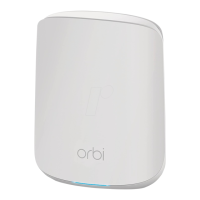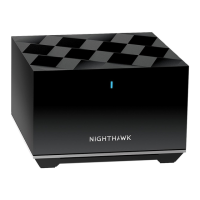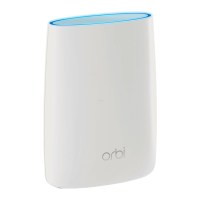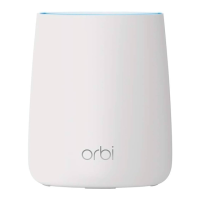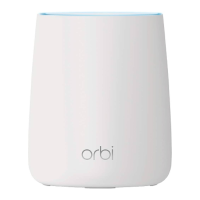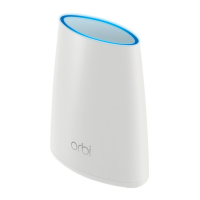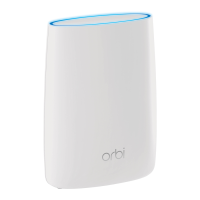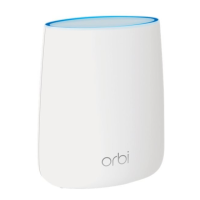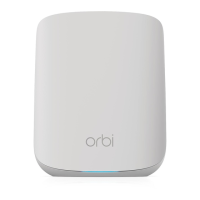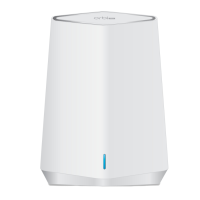
Do you have a question about the NETGEAR Orbi Pro WiFi 6 Mini and is the answer not in the manual?
| Model | SXK30 |
|---|---|
| Maximum WiFi Speed | Up to 1.8 Gbps |
| WiFi Performance | AX1800 |
| Security | WPA3 |
| MU-MIMO | Yes |
| OFDMA | Yes |
| Beamforming | Yes |
| Guest Network | Yes |
| Parental Controls | Yes |
| Antenna | Internal |
| Management | Orbi app, web interface |
| WiFi Standard | Wi-Fi 6 (802.11ax) |
| Frequency Bands | Dual-band (2.4 GHz & 5 GHz) |
| Coverage Area | Up to 4, 000 sq ft |
| Ethernet Ports | 2 |
Guide to automatically detect and configure internet connection settings for the router.
Steps to manually configure internet connection settings, with or without login.
Procedure to configure internet connection when no login is required by the ISP.
Procedure to configure internet connection requiring login credentials from the ISP.
Configuration options for setting up an IPv6 internet connection manually.
Information on adjusting the Maximum Transmission Unit size for optimal network performance.
Manage device access to the network based on MAC addresses for specific networks.
Procedure to enable MAC Access Control and set default policies for networks.
How to add detected devices to the MAC Access Control list.
Steps to manually manage devices within a MAC Access Control list.
Procedure to disable MAC Access Control for a specific network.
Manage access to the entire Orbi network using MAC addresses of connected devices.
How to enable network access control and define rules for new devices.
Configure which devices are allowed access to the Orbi network.
Configure which devices are blocked from accessing the Orbi network.
Method to block specific internet sites using keywords.
Steps to remove keywords from the internet site blocking list.
Exempting a specific computer from internet access blocking rules.
Configure rules to block specific internet services.
Set schedules for blocking internet sites and services.
Configure email alerts for router activity and security events.
Explanation of Virtual Local Area Networks (VLANs) and their advantages.
Details on the router's Virtual Local Area Network (VLAN) management capabilities.
Explanation of how the router segments networks using LANs, VLANs, and WLANs.
Information on creating and managing VLAN profiles.
Steps to create a new VLAN profile with specific settings.
Procedure to add a VLAN profile directly to a specific LAN port.
How to modify client and network isolation settings for VLAN profiles.
Instructions for removing a VLAN profile.
Assigning LANs, WiFi networks, or ports to specific VLAN profiles.
Steps to change the VLAN profile assigned to a specific LAN.
Manage VLAN profile assignments for WiFi networks.
Procedure to assign VLAN profiles to Ethernet ports.
Explanation of Ethernet port modes: Trunk and Access.
Overview of the router's four supported WiFi networks (WLANs).
Information on the default administrative WiFi network (Wireless 1).
How to modify the SSID, channel, or VLAN for the admin WiFi network.
Steps to change the WiFi password and security settings for the admin network.
Details about the Employee WiFi network (Wireless 2) and its isolation.
Procedure to enable and configure the employee WiFi network.
How to change the password and security for the employee WiFi network.
Information on the IoT WiFi network (Wireless 3) for smart devices.
Steps to enable and configure the IoT WiFi network.
How to change the password and security for the IoT WiFi network.
Setup for a guest WiFi network with optional captive portal.
Configure guest network with open or password-protected access.
Enable Facebook Wi-Fi for guest access, requiring a Facebook check-in.
Configure a captive portal for guest WiFi access with terms and conditions.
Explanation of Local Area Networks (LANs) and their role in network segmentation.
Overview of configurable LAN settings for each of the five LANs.
Steps to modify IP address and subnet mask for the default LAN 1.
Procedure to modify IP address and VLAN settings for the employee LAN 2.
Steps to modify IP address and VLAN settings for the IoT LAN 3.
Procedure to modify IP address and VLAN settings for the guest LAN 4.
How to configure custom VLAN profile settings for LAN 5.
Information on configuring Dynamic Host Configuration Protocol (DHCP) servers for each LAN.
Procedure to configure DHCP server settings for LAN 1.
Procedure to configure DHCP server settings for the employee LAN 2.
Procedure to configure DHCP server settings for the IoT LAN 3.
Procedure to configure DHCP server settings for the guest LAN 4.
Procedure to configure DHCP server settings for the custom LAN 5.
Instructions to disable the router's DHCP server feature for a specific LAN.
Information on assigning static IP addresses to devices via DHCP reservation.
Steps to reserve a specific IP address for a device on the network.
Procedure to modify existing reserved IP address entries.
Instructions for removing a reserved IP address entry.
Configuration options for Wide Area Network (WAN) settings and security features.
Information on using Dynamic DNS services to access the network remotely.
Steps to register for and set up a new NETGEAR Dynamic DNS account.
How to configure the router to use an existing Dynamic DNS account.
Procedure to modify existing Dynamic DNS account settings.
Configure a Demilitarized Zone (DMZ) server for specific applications.
Information on setting up static routes for network traffic management.
Steps to manually define a static route for network traffic.
Procedure to edit existing static route configurations.
Instructions for removing a static route entry.
Enable Universal Plug and Play (UPnP) for automatic device configuration.
Information on setting up Link Aggregation Groups (LAGs) for increased throughput.
Steps to create a Link Aggregation Group (LAG) between devices.
Procedure to remove an existing Link Aggregation Group (LAG).
Guide to establishing a LAG connection between satellite and router.
Information on checking and updating router and satellite firmware.
How to configure the router for automatic firmware updates.
Steps to manually check for and install available firmware updates.
Detailed instructions for manually updating device firmware.
Procedure to manually update the firmware on an Orbi satellite.
Procedure to manually update the firmware on the Orbi router.
Information about the admin password for router and satellite web interfaces.
Steps to change the admin password for secure access.
How to enable the password reset feature using security questions.
Procedure to reset the admin password if forgotten, using security questions.
Overview of monitoring router, satellite, and network status.
How to check the router's status and resource usage.
Accessing satellite status information via its web interface.
How to view all devices connected to the Orbi network.
How to check and renew the router's internet connection status.
View detailed statistics for router ports and WiFi radios.
How to test your internet connection speed using Speedtest.
How to view and manage router activity logs.
Configure the router to send system logs to a syslog server.
Enable and use traffic metering to monitor and control internet data usage.
How to start the traffic meter without setting usage limits.
Set monthly data volume limits for internet traffic.
Set monthly connection time limits for internet usage.
How to view traffic volume and statistics from the traffic meter.
Procedure to re-enable internet access after traffic limits are met.
Configure the router's Network Time Protocol (NTP) server settings.
Manually set the router's time zone and daylight saving settings.
Information on managing router configuration files (backup, restore, reset).
Steps to back up the router's current configuration settings.
Configure automatic backup schedules for router settings.
Procedure to restore router configuration from a backup file.
How to reset the router to its factory default configuration settings.
Enable and configure remote management of the router over the internet.
Step-by-step guide to enable remote management access.
Information on how to use remote access to manage the router.
Configure the router to function as an Access Point (AP).
Procedure to configure the router to operate in Access Point (AP) mode.
Switch the router back to its default router operation mode.
Procedure to revert the router from AP mode back to router mode.
Manage the security settings for the physical Sync button.
How to enable or disable the Sync button on the router.
How to enable or disable the Sync button on the satellite.
Manage download bandwidth allocation for each WiFi network (SSID).
Set the region for router operation to comply with local regulations.
Enable or disable broadcasting of WiFi network names (SSIDs) for security.
Configure 20/40 MHz coexistence settings for the 2.4 GHz WiFi radio.
Enable or disable Wi-Fi Multimedia (WMM) to prioritize traffic.
Configure CTS/RTS threshold and preamble mode settings for WiFi radios.
Adjust the transmission output power for WiFi radios.
Generate and manage the backhaul password for WiFi communication.
Enable or disable Multi-User Multiple Input Multiple Output (MU-MIMO) for performance.
Configure Protected Management Frames (PMF) for enhanced WiFi security.
Allow specific incoming traffic to reach local servers or applications.
Steps to configure port forwarding for specific incoming protocols.
How to define and add a custom port forwarding service.
Procedure to modify existing port forwarding service entries.
Instructions for removing a port forwarding entry.
Configure dynamic port opening based on outbound traffic.
Steps to add a new port triggering service.
Procedure to enable port triggering for added services.
Explanation of Virtual Private Network (VPN) client-to-gateway tunnels.
Requirement for different LAN IP schemes for VPN connection to work.
Steps to enable and configure the OpenVPN service on the router.
Guide to installing OpenVPN client software and configuration files.
Instructions for installing OpenVPN client utility and config files on Windows.
Instructions for installing OpenVPN client utility and config files on Mac.
Instructions for installing OpenVPN Connect app and config files on iOS.
Instructions for installing OpenVPN Connect app and config files on Android.
How to use VPN to access business internet service remotely.
Configure router to allow VPN clients to access the internet.
Configure router to block VPN clients from accessing the internet.
General tips for troubleshooting common router and network issues.
Recommended sequence for restarting network devices to resolve issues.
Check for matching WiFi network names (SSID) and security settings.
Verify computer network settings, ensuring IP addresses are on the same subnet.
Troubleshooting steps if the router and satellite fail to sync.
Procedure for syncing the satellite with the router.
Steps to resolve issues preventing login to the router's web interface.
Troubleshooting steps for when the router is connected but has no internet access.
Diagnose and fix issues related to loading web pages from the internet.
Steps to troubleshoot PPPoE internet connection issues.
Steps to diagnose and resolve problems connecting to WiFi networks.
Using the ping utility to diagnose network connectivity.
Verify the Local Area Network (LAN) path to the router.
Verify the network path from the computer to a remote device.
Example configuration for VLANs in a home network setup.
Example configuration for VLANs in a business network setup.

